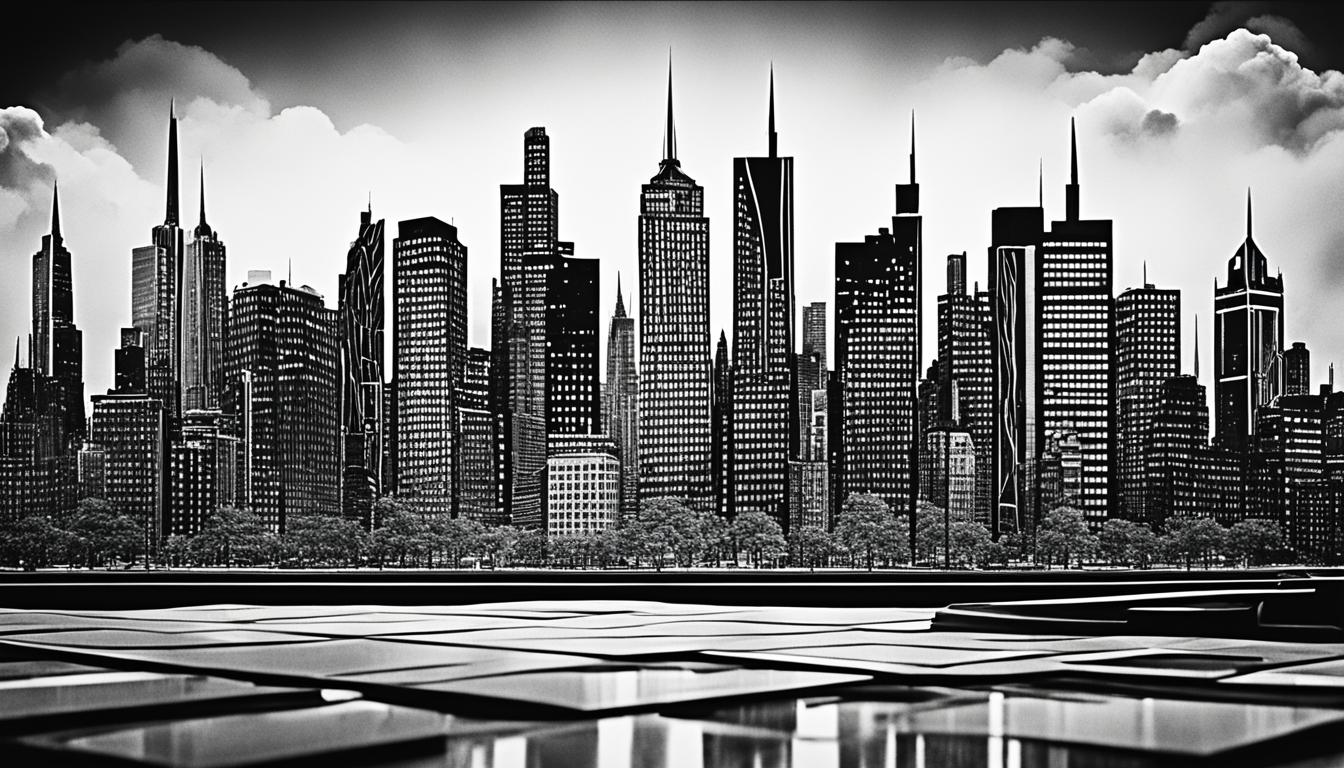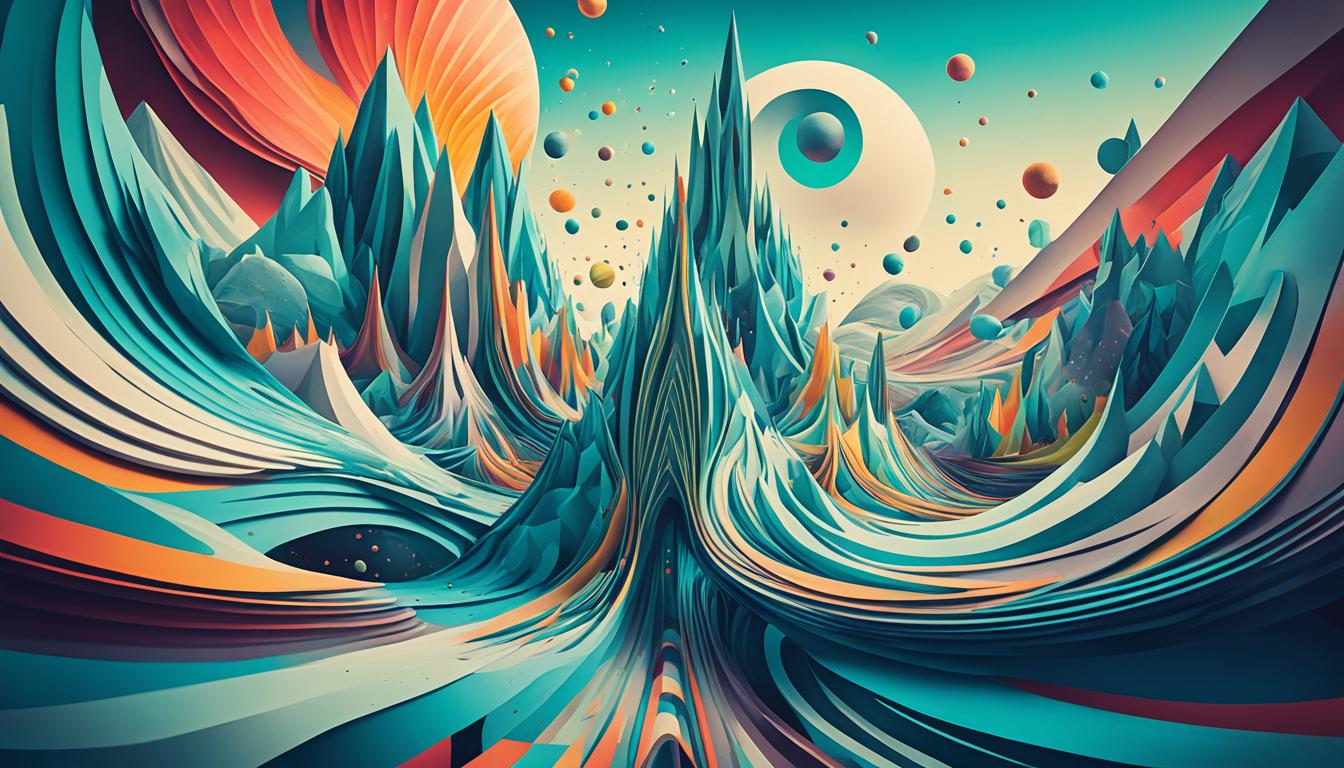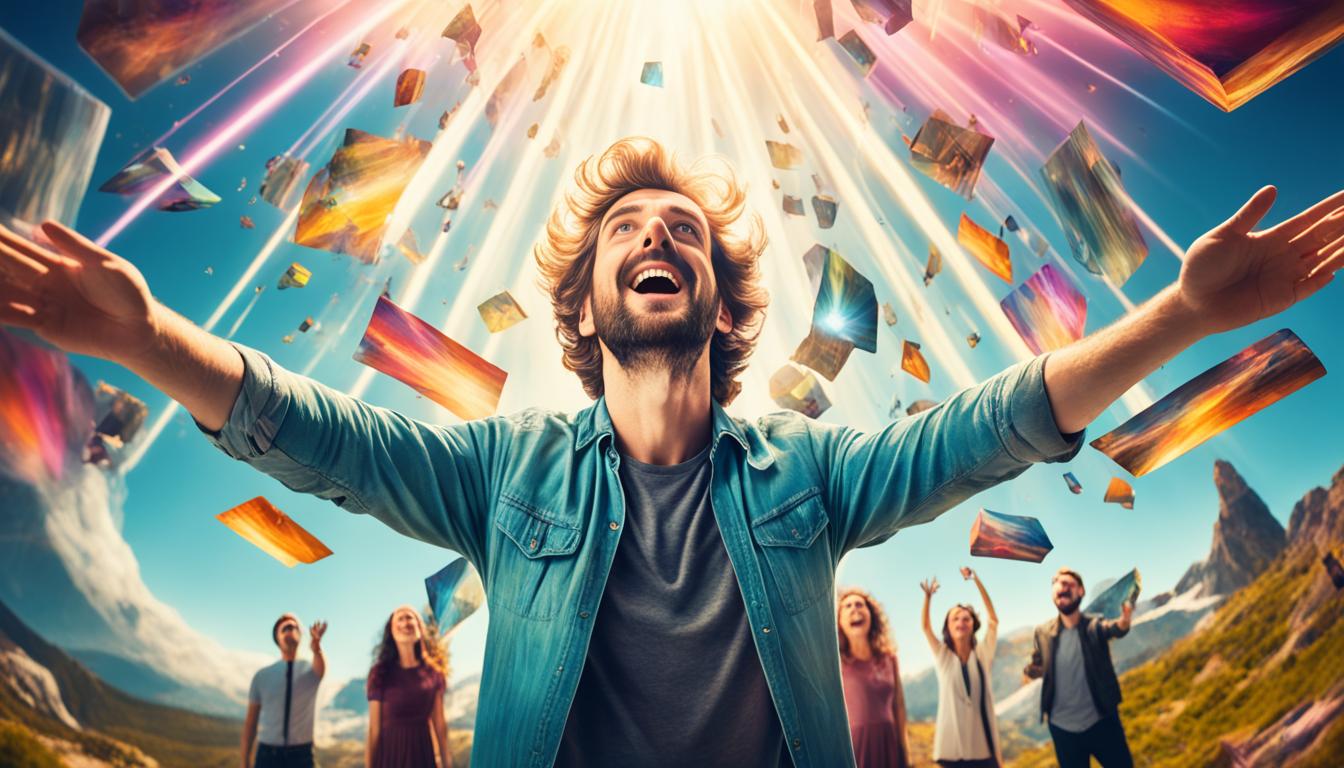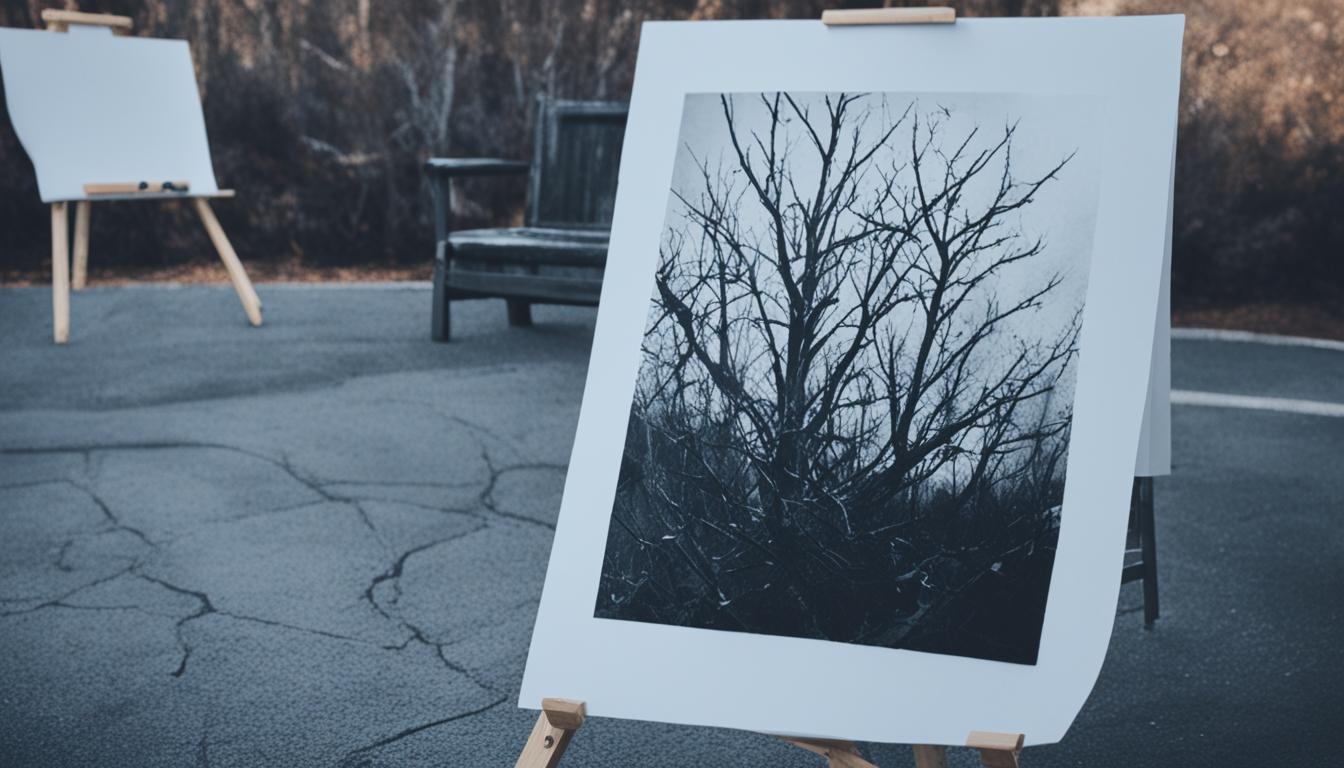At the intersection of fine art photography and digital art lies a realm of endless creativity and artistic expression. With the advent of digital tools and techniques, photographers have gained the power to transcend the boundaries of traditional photography and explore new artistic possibilities. Blending photography and digital art allows artists to push the limits of their craft, creating captivating and visually stunning pieces that challenge the notion of what art can be.
Key Takeaways:
- Fine art photography and digital art offer a unique fusion of artistic mediums.
- Blending photography and digital art allows for experimentation with color, texture, and composition.
- Studying the works of renowned artists in this field can inspire new techniques and approaches.
- Collecting textures and harnessing layering techniques are vital in creating artistic blends.
- Mastering opacity control and understanding color theory are essential skills for seamless blending.
Exploring Fine Art Photography as a Source of Inspiration
Fine art photography is a treasure trove of inspiration, offering a wealth of ideas for artists seeking to blend photography with digital art. Renowned artists such as Jim DiVitale, Julianne Kost, and Thom Rouse have paved the way by experimenting with multiple images and layering techniques, resulting in visually striking and unique artwork.
Studying the techniques employed by these artists can provide valuable insights for photographers aiming to converge fine art photography with digital media. By analyzing their use of composition, color, and texture, we can gain a deeper understanding of how blending these two art forms can lead to stunning visual creations that challenge the boundaries of traditional art.
This captivating image showcases the beauty and evocative power of fine art photography. Its mesmerizing composition and subtle play of light and shadow inspire artists to explore new possibilities in their own creative journeys.
Another source of inspiration lies in the world of contemporary art trends. By immersing ourselves in museums and galleries, we can observe the innovative techniques employed by painters and other traditional artists. Their mastery of color, brushwork, and composition can offer fresh insights into creating dynamic and vivacious digital artwork.
“Painting is poetry that is seen rather than felt, and poetry is painting that is felt rather than seen.” – Leonardo da Vinci
These words from the maestro himself remind us that the art of painting is not limited to a single medium but can serve as a wellspring of inspiration for photographers as well. By blending the brushstrokes of traditional art with the pixels of digital media, we can breathe new life into our photographs, transporting viewers to an ethereal realm where beauty transcends the boundaries of conventional art.
Embracing the Symbiosis of Fine Art Photography and Digital Media
To fully embrace the convergence of fine art photography and digital media, we must delve into the interplay of various artistic elements. The careful selection of color palettes, the harmonious blending of textures, and the juxtaposition of different visual elements can enhance the impact of our artwork and captivate the viewer’s imagination.
Throughout this journey of discovery, it is essential to experiment, take risks, and seek inspiration not only from fine art photography but from various artistic disciplines. By embracing cross-pollination and expanding our artistic horizons, we can unlock boundless creative potential and craft artwork that resonates with the contemporary art world.
| Benefits of Exploring Fine Art Photography as a Source of Inspiration | Challenges to Overcome |
|---|---|
| 1. Incorporate unique techniques and concepts into digital art | 1. Balancing the authenticity of fine art with the flexibility of digital media |
| 2. Broaden artistic horizons and challenge traditional notions of art | 2. Maintaining consistency and coherence in blended artwork |
| 3. Gain insights from established artists and art movements | 3. Balancing technical proficiency with artistic expression |
By traversing the realm of fine art photography, we embark on a journey of artistic exploration that intertwines tradition and innovation. As we navigate this path, we discover the profound impact that the intersection of fine art and digital media can have on our artistic endeavors.
Collecting Textures and Building Artistic Creations
When it comes to creating unique and visually captivating artwork, one technique that photographers and digital artists often employ is the artistic manipulation of digital photography through the collection and blending of textures. Textures can be found all around us, in the natural world and man-made objects alike. Whether it’s the rough bark of a tree, the smooth surface of metal, the peeling paint on a wall, or the wisps of clouds in the sky, these textures serve as building blocks for artistic creations that seamlessly blend the world of fine art photography with digital techniques.
By combining and layering textures using software like Photoshop, artists can transform their images into painterly masterpieces. The possibilities are truly endless when it comes to the artistic manipulation of digital photography. Through the use of blend modes, masks, adjustment layers, and layer styles, photographers can manipulate and blend different textures to create a unique composition that evokes emotion and captures the viewer’s imagination.
Experimentation is key in this creative process. As artists explore and discover different textures and techniques, they are able to push the boundaries of what is possible and unlock new levels of artistic expression. It’s through this exploration that new and unique artistic possibilities emerge, resulting in breathtaking creations that challenge traditional notions of art.
“The blending of textures in digital photography is a gateway to endless artistic possibilities.” – Photographer’s Magazine
Creating Textures: Nature’s Inspiration
Nature provides a multitude of textures that can be incorporated into digital artwork. The roughness of tree bark, the delicate petals of a flower, or the intricate patterns of a leaf can all add depth and dimension to photographs. By carefully capturing these textures in their raw form, artists can create a library of resources that can be used to build their artistic creations.
Exploring Man-made Textures
Textures can also be found in man-made objects, such as fences, walls, or rusted metal surfaces. These elements often possess unique characteristics that can add a touch of realism or create an abstract effect in digital artwork. By embracing the imperfections and unique qualities of man-made textures, artists can create visually striking compositions that tell a story and capture the viewer’s attention.
Blending Textures for Artistic Expression
The process of blending different textures involves layering them using software like Photoshop. By experimenting with blend modes, artists can create unique combinations that result in beautiful and harmonious blends. Masks, adjustment layers, and layer styles can further refine the blend, allowing artists to manipulate the intensity and opacity of each texture layer.

The artistic manipulation of digital photography through the blending of textures opens up a world of creative possibilities. By collecting textures from nature and man-made objects and skillfully blending them using digital techniques, artists can create visually stunning and thought-provoking artwork that challenges traditional boundaries.
Layering Techniques for Blending Images
Layering is a fundamental technique in blending images in both fine art photography and digital art. By using software like Adobe Photoshop, we can layer multiple images together and experiment with different blend modes.
Blend modes in Photoshop work with brightness and darkness values, allowing us to create unique and painterly effects in our artwork. By adjusting the opacity of each layer, we can control the visibility and intensity of different elements within the image. This technique allows for the creation of seamless transitions and a painterly effect that adds depth and dimension to the artwork.
Whether we’re layering images to blend textures, incorporate different elements, or combine multiple exposures, the layering technique offers immense creative possibilities. Let’s dive deeper into the techniques and tools involved in layering images to create captivating blends.
Experimenting with Blend Modes
One of the key aspects of layering images is the ability to experiment with different blend modes in Photoshop. Blend modes determine how each individual layer interacts and combines with the layers beneath it. By selecting the appropriate blend mode, we can achieve desired effects such as overlaying textures, enhancing colors, or creating composite images with seamless transitions.
Some commonly used blend modes include:
- Multiply: Darkens the image and blends the colors together.
- Screen: Lightens the image and allows the colors to blend.
- Overlay: Creates a mix of Multiply and Screen blend modes, resulting in enhanced contrast and saturation.
- Soft Light: Adds a subtle glow and softens the image.
- Hard Light: Intensifies the contrast, creating a dramatic effect.
By experimenting with different blend modes, we can achieve a variety of effects and artistic looks in our blended images.
Controlling Opacity for Seamless Blends
Another essential aspect of layering images is controlling the opacity of each layer. Opacity determines the transparency and visibility of the layer, allowing us to blend different elements seamlessly. By adjusting the opacity, we can achieve gradual color transitions, smooth blends, and create a harmonious integration of different images.
“Controlling the opacity of each layer is akin to fine-tuning the composition and blending elements together in perfect harmony.”
Gradually building up the opacity of brush strokes or adjusting the overall opacity of a layer allows us to maintain control over the blending process. This technique ensures that our blends appear natural and seamless, resulting in artwork that is visually captivating.
Creating Depth and Dimension with Layer Masks
Layer masks are powerful tools in layering images. They allow us to selectively apply or hide parts of a layer, giving us precise control over the blending process. By using layer masks, we can seamlessly blend different elements, control the visibility of specific areas, and create depth and dimension in our artwork.
“Layer masks are our gateway to creating complex and intricate blends that seamlessly integrate different elements and create a sense of depth.”
With layer masks, we can use brushes to paint on or erase parts of a layer, revealing or hiding the underlying layers. This technique allows for precise blending, enabling us to seamlessly incorporate textures, refine edges, or create composite images with intricate details.
Enhancing Blends with Adjustment Layers
Adjustment layers are valuable tools for enhancing blends and adjusting the overall appearance of our layered images. They allow us to make non-destructive adjustments to aspects such as brightness, contrast, saturation, and color balance. By adding adjustment layers, we can fine-tune our blends and achieve the desired artistic effect.
“Adjustment layers provide us with the flexibility to refine our blends further, ensuring that our artwork portrays our creative vision.”
Some commonly used adjustment layers include:
- Brightness/Contrast: Adjusts the overall brightness and contrast of the image.
- Curves: Enables precise control over the tonal range and contrast.
- Hue/Saturation: Alters the hue, saturation, and lightness of specific colors.
- Selective Color: Adjusts the intensity of specific color channels.
By using adjustment layers in combination with layer blending techniques, we can take our blends to the next level and truly express our artistic vision.
Mastering Opacity Control for Seamless Blending
Opacity control is an essential skill for achieving seamless blending in digital art. By adjusting the opacity of our digital brush strokes, we can control the transparency and intensity of the colors we are blending. By lowering the opacity levels, we can create gradual color transitions, resulting in a smooth blend between different elements of our artwork. This technique allows for a natural and nuanced look in our blends, adding depth and dimension to our digital creations.
When we gradually build up the colors with lower opacity, we can achieve a seamless integration of different elements. This technique is particularly effective when blending different layers or merging different images together. With opacity control, we can ensure that the elements in our artwork blend harmoniously and create a visually appealing composition.
Using opacity control gives us the power to create depth in our artwork. By strategically adjusting the transparency of our brush strokes, we can add layers of colors and create dynamic contrasts. This technique adds visual interest and complexity to our artwork, capturing the viewer’s attention and creating a sense of depth and dimension.
Opacity control also allows for creative experimentation. By varying the opacity levels, we can explore different blending effects and create unique artistic outcomes. We can play with the interaction of colors, textures, and layers, pushing the boundaries of our creativity and discovering new possibilities in our artwork.
To harness the full potential of opacity control in blending, it is crucial to practice and experiment regularly. Through trial and error, we can refine our understanding of how opacity impacts the blending process and develop our own unique style. By seeking feedback from fellow artists and mentors, we can gather valuable insights and refine our opacity control techniques.
Overall, mastering opacity control is a fundamental skill for achieving seamless blending in digital art. By manipulating the transparency and intensity of our colors, we can create visually stunning artwork with gradual color transitions. Opacity control adds depth, dimension, and an element of surprise to our blends, allowing us to create artwork that captivates and resonates with viewers.
Opacity Control Techniques
| Technique | Description |
|---|---|
| Adjusting opacity sliders | By using the opacity sliders in digital art software, we can control the transparency of our brush strokes and layers. |
| Layering with different opacity levels | Creating multiple layers with varying opacity levels allows for gradual color transitions and seamless blends. |
| Experimenting with blending modes | Blending modes in software like Photoshop can produce different opacity effects and enhance the blending process. |
| Gradual build-up of colors | By gradually applying color with lower opacity, we can achieve a natural and nuanced look in our blends. |
Harnessing the Power of Colors in Blending
Colors are not just mere visual elements in digital art; they also play a profound role in the blending techniques used by artists. Understanding color theory and how different colors interact with each other is crucial for creating harmonious blends. By mastering the art of color blending, artists can evoke emotions, set the mood, and add depth to their artwork.
When blending colors, artists have the opportunity to create dynamic contrasts and intricate details that captivate the viewer. By effectively mixing colors and employing various color blending techniques, artists can enhance the visual impact of their blends and guide the viewer’s eyes through the artwork.
Experimenting with different color combinations and temperature can yield remarkable results. By exploring the possibilities of color, artists can evoke specific emotions and imbue their artwork with a particular mood. Warm colors like red and orange can evoke passion and energy, while cool colors like blue and green can convey calmness and serenity. By understanding how colors interact and affect emotions, artists can create powerful compositions that resonate with viewers.
“Color is a power which directly influences the soul.” – Wassily Kandinsky
To demonstrate the significance of color blending, consider the following examples:

| Color Combination | Effect |
|---|---|
| Contrasting complimentary colors | Creates a vibrant and energetic composition |
| Analogous colors | Produces a harmonious and balanced artwork |
| $- Colors with contrasting temperature (warm and cool) | Induces a sense of depth and dimension |
| $- Monochromatic hues | Allows for subtle variations within a single color family |
By harnessing the power of colors in blending, artists have the ability to create visually captivating and emotionally engaging artwork. Through experimentation and a deep understanding of color theory, they can elevate their artistic expressions and make a lasting impact on their audience.
The Importance of Regular Practice and Experimentation
Like any skill, mastering blending techniques for digital art requires regular practice and experimentation. The more we practice, the better we will become at blending our images seamlessly and creating captivating artwork.
It is essential to experiment with different techniques, software, and brushes to discover what works best for our individual artistic styles. Trying out new approaches and exploring various tools will help us push the boundaries of our creativity and uncover innovative blending techniques.
Seeking feedback from other artists and mentors is also valuable in our journey to improve our blending skills. Their insights and suggestions can provide fresh perspectives and help us refine our techniques. By embracing constructive criticism, we can grow as artists and become more proficient in our craft.
Benefits of Regular Practice and Experimentation:
- Enhanced Skill Development: Through consistent practice, we can refine our blending techniques and develop a strong command over the tools and software we use. Regular experimentation allows us to expand our artistic repertoire and uncover new approaches to create visually stunning artwork.
- Increased Creativity and Innovation: By exploring different techniques and tools, we stimulate our creativity and broaden our artistic horizons. Experimenting with new ideas and pushing the boundaries of what we know encourages innovation and can lead to the development of unique artistic styles and techniques.
- Adaptability and Flexibility: Regular practice and experimentation help us become more adaptable to different artistic challenges and styles. We become more comfortable working with various tools and techniques, allowing us to tackle a wide range of blending projects with confidence and creativity.
- Personal Growth and Artistic Identity: Through continuous practice and experimentation, we not only improve our technical skills but also gain a deeper understanding of our artistic style and preferences. This self-discovery contributes to the development of a unique artistic identity that sets us apart.
“Regular practice and experimentation are the keys to unlocking our artistic potential and creating artwork that truly stands out.”
Remember, regular practice and experimentation are essential for growth as a digital artist. Embrace the opportunity to refine your techniques, seek feedback, and embrace the joy of creating artwork that reflects your unique style and vision.
So let’s continue our journey of discovery and improvement, armed with the knowledge that every brushstroke, every blend, and every creation brings us closer to realizing our artistic potential.
Conclusion
The intersection of fine art photography and digital art offers a vast array of artistic possibilities. By blending the techniques of both mediums, we can create visually stunning and dynamically engaging artwork that challenges traditional notions of art. Through the use of layering, opacity control, color blending, and regular practice, we can develop our own unique style and push the boundaries of what is possible in the world of art.
By combining multiple images and experimenting with blend modes, we can create seamless transitions and a painterly effect that adds depth and dimension to our artwork. Opacity control allows us to achieve seamless blending and gradual color transitions, creating a natural and nuanced look. Additionally, understanding color theory and using colors effectively can evoke emotions and enhance the visual impact of our blends.
To truly unlock the artistic possibilities, it is crucial to nurture our creativity through regular practice and experimentation. By exploring different techniques, seeking feedback from other artists, and embracing new approaches, we can continuously refine our skills and create artwork that stands out. With the right tools and a willingness to experiment, we can push the boundaries of what is possible and create artwork that captivates and inspires.
FAQ
What is the intersection of fine art photography and digital art?
The intersection of fine art photography and digital art refers to the blending of these two artistic mediums to create unique and visually stunning artwork. Through the use of digital tools and techniques, photographers can manipulate their images and blur the line between photography and digital art.
How can fine art photography serve as a source of inspiration?
Fine art photography serves as a rich source of inspiration for artists looking to blend photography with digital art. By studying the techniques used by renowned artists in the field, photographers can gain valuable insights into how to blend these two art forms together.
How does collecting textures contribute to building artistic creations?
Collecting textures is a common practice among photographers and digital artists. These textures, found in various elements of our surroundings, serve as building blocks for creating artistic creations that blend fine art photography with digital techniques.
What are layering techniques in blending images?
Layering is a fundamental technique used in blending images in both fine art photography and digital art. By layering multiple images and experimenting with different blend modes, artists can create unique and painterly effects in their artwork.
How does opacity control enhance seamless blending in digital art?
Opacity control is a crucial skill for achieving seamless blending in digital art. By adjusting the transparency and intensity of the colors being blended, artists can create smooth transitions and a natural and nuanced look in their artwork.
How do colors play a role in blending techniques for digital art?
Colors play a significant role in blending techniques for digital art. By understanding color theory and how different colors interact with each other, artists can create harmonious blends that evoke emotions, set the mood, and add depth to their artwork.
Why is regular practice and experimentation important in mastering blending techniques?
Regular practice and experimentation are essential in mastering blending techniques for digital art. By continuously exploring different techniques and seeking feedback from other artists, individuals can refine their skills and develop their own unique style.
What are the artistic possibilities of blending fine art photography with digital art?
Blending fine art photography with digital art opens up a world of artistic possibilities. By combining the techniques of both mediums, artists can create visually stunning and dynamically engaging artwork that challenges traditional notions of art.
How Can Collaborations Enhance the Blending of Fine Art Photography with Digital Art?
Fine art photography collaborations can enhance the blending of traditional photography with digital art by bringing together different perspectives and techniques. Collaborating with digital artists can result in innovative and unique works that push the boundaries of what fine art photography can achieve in the digital age.




